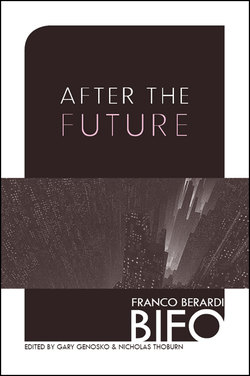After the Future

Реклама. ООО «ЛитРес», ИНН: 7719571260.
Оглавление
Franco "Bifo" Berardi. After the Future
Отрывок из книги
Edited by Gary Genosko and Nicholas Thoburn
Translated by Arianna Bove, Melinda Cooper, Erik Empson, Enrico,
.....
Henri Bergson says that cinema demonstrates a close relationship between consciousness and the technical extroversion of movement in time. For the first time in human history, cinema makes possible the re-actualization of an action that happened in the past, and gives us the possibility of coming back to the future when future has become past. In 1912, Delaunay, a pupil of Bergson, wrote in a letter to the Italian Futurists: “Your art has velocity as expression and the cinema as a tool.” The Manifesto tecnico della pittura futurista [Futurist Painting: Technical Manifesto], written in 1910 and signed by Boccioni, Balla, Carrà, Severini, and Russolo (1970, 27), proclaims the idea of dynamism: “The gesture which we would reproduce on canvas shall no longer be a fixed moment in universal dynamism. It shall simply be the dynamic sensation itself.”
Futurist dynamism wants to infuse painting with the perception of temporal progression, as we can see in Balla’s painting Signorina con cagnolino, and in Boccioni’s Stati d’animo. Futurist innovation exploits the rhythm of technomedia innovation: photography, cinema, radio. Cubo-Futurist painters try to capture the dynamic of movement by simultaneously presenting different sides of the object, anticipating the sensibility of cinema and television. Velimir Khlebnikov and Aleksei Kruchenykh sing the praises of radio as the medium of universal love and sympathy among men. After dreaming of the evolution of the media, after proclaiming the advent of universal communication and wireless imagination, in the second half of the century the avant-garde will witness the conversion of the media into tools of domination over the collective mind. But the ambiguity is there from the beginning.
.....